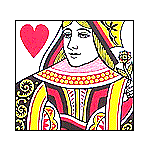Down - Up
CG 1 : Introduction
Charles Goren, the undisputed "Mr.Bridge" of the 20th century, created the
Goren system in the 1930s.
He used as keystone for his system the opening
bid of 1NT = 16-18 points, reputedly borrowed from an earlier convention
from the preceding auction bridge period.
Around this focal point of his
system Goren devised a symmetrical sequence of 3 HCP bidding segments : 13-
15, 16-18, 19-21, 22-24 and 25-27 which could be revealed through specific
opening bids, responses and rebids.
Over the next half century little changed except for the system's new name,
"Standard American", and the conversion from a 4-card major to a 5-card major
bidding system.

However after Charles Goren's death in 1991 some changes have been gradually
introduced (and formalised in the SAYC system*).
Some of these alterations have disturbed both the symmetry and some of
Goren's clever underlying intelligent bridge logic underpinning his system.
Two changes published in some teaching manuals (but not adopted by Jazclass
Bridge online) and in widespread use by novice players in the
USA and Australia are discussed below.
* Standard
American Yellow Card system (for novices tournaments)
Down - Up
CG 2 : The 1NT
Opening bid
In recent years statistical evidence has revealed that a combined strength of
25 HCP is enough to make a Game contract of 3NT or 4♥ or 4♠
55% of the time.
Consequently most players worldwide have reduced their Game strength
target by 1 HCP from 26 HCP to 25 HCP.

Whereas the other two
mainstream bidding systems (Acol and Precision) absorbed this change by
adjusting their responses, Standard American reduced the range
of their 1NT Opening bid from 16-18 to 15-17 HCP. (The 1 in a suit
opening range was also widened from 13-15 to 12-15 points.)
This shift of the central 1NT opening bid range has two adverse effects
on the bidding system :
- It distorts the symmetry of the original system
- It widens the range of balanced opening hands stronger than
1NT that require a 1-level opening bid from 19-21 to 18-21
HCP.
#
It therefore increases the
number of deals where Opener is left stranded in his opening bid of
1♣ or 1♦ after the other three hands pass all
round.
Jazclass Bridge
In line with professional statistical analyses revealed in a recent
publication "Better Balanced Bidding" (Jackson & Klinger, 2010) Jazclass Bridge
now uses the Extended Milton HCP valuation by counting ½ a HCP
for each 10.
A = 4
K = 3
Q = 2
J = 1
10 = ½
This increases the total of HCP in a deal from 40 to 42 HCP and
restores the Game points target to 26 points.
As a result the
original Standard American system remains largely unchanged and the adverse
effects (1 and 2) stated above are avoided.
At the same time a more
aggressive approach towards reaching a Game contract
(25/40 > 26/42)
is achieved, while the hand valuation method has been improved.
#: Jazclass
Bridge has removed this gap entirely by means of a slight modification
of the system presented in Intermediate Lesson
9.
Down - Up
CG 3 : Suite raise Responses
Charles Goren's selection of suit raise responses was based on a well
thought through strategy, incorporating three intelligent ideas.
1. The Game Force raise : 1♠ - 3♠
Rather than a direct raise to Game (4♥ or
4♠) by a Responder with 13+ points, Goren
defined the single jump raise (1♥ - 3♥ or 1♠ - 3♠) as the Game force response. This
allowed for Slam investigation (cue bids, multi cues, slam trial bids) to
commence at a lower level, providing more bidding space.
In modern day bridge this also allows for the
Blackwood Convention to start with 3NT, rather than 4NT (see my
Intermediate Lesson 6).
This provides an
extra level of bidding, and (in case of a negative result) enables the
partnership to stop at the 4-level instead of the 5-level (as in
traditional Blackwood).

2. The Limit bid raise : 1♠ - 2♦ - 2NT - 3♠
Responses of 11-12 pts (later also 10 pts with 8 losers) must bid a
new suit first, then raise Opener's suit to the 3-level on their 2nd
turn.
This also makes good sense, as Responder's raise to the 3-level is
invitational, so that his first bid provides additional information
about his hand to help Opener decide whether to bid Game or not.
3. The Pre-emptive Game raise : 1♠ - 4♠ 
This is an iconic Goren bid. The response shows a weak hand in terms of HCP
(6-10 HCP) but with a singleton or void and 4+trump support for Partner's
major suit.
The ruffing potential of this favourable hand distribution makes up for the lack in HCP
and Game contracts are easily achieved with these type of hands
(even opposite a minimum Opening hand).
This is an important member of the
suit raise response options which many novice players appear to overlook
consistently.
Hands with the same unbalanced distribution
but more HCP (11+HCP and 7 losers) represent the seamless transition
from a pre-emptive raise (1♥ -
4♥) to a Splinter raise (1♥ - 4♣) where the double jump-shift to a new suite
shows the hand's singleton or void (see my Intermediate Lesson 2).
Unfortunate common current usage
Present common usage is to reverse the Limit raise and Game Force
raises :
- 1♥ - 3♥ = 10-12 points with trump support
- 1♥ - bid new suit first =
13+ points with trump support
If you absolutely insist on using 1 above I
recommend you use Jacoby 2NT with 13+ pts and trump support.)
The necessity to bid a new suit first produces a variety of muddled
rebids by many novice players :
- a 2nd round response of 3♥ showing
16+ pts, or 4♥ showing 13-15
pts.
This is the correct response under these
circumstances.
- an indiscriminate 2nd round response of 4♥, showing 13+ pts
- some players do not bid a new suit first and raise directly to
4♥.
In the
process nullifying the Pre-emptive Game raise response.
The upshot of all this is that many players going through above muddle
rarely investigate for a possible Slam, and fail to reach numerous Slam
contracts which otherwise would have been easy to bid.

Players of good Intermediate and higher
skill level use the single jump raise response (1♥ - 3♥) to show a weak hand (6-9 HCP) with 4+trumps
but no singleton or void. A "mini Goren pre-emptive raise" you might call
it.
These bids are standard responses when using Conventions like the
Bergen raises, Inverted minors, and (after Enemy interference, in association
with) Cue bid raises and Truscott 2NT responses.
In other words the single jump raise has a clear function in two different
bidding strategies :
- Either it is a Game force response, showing 13+ pts (in a basic system)
- or it is a mini pre-emptive raise, showing 6-9 HCP (in an advanced system)
Using the single jump raise as a Limit raise response (10-12) clearly
falls into no-men's land between the above two strategies.
Top - Up
CG 4 : The Emperor's clothes
Like the little boy in the famous fairy tale, history shows again and again
that being on your own usually is the precursor to proving to be
right.
Many novice players however go the opposite way, seeking
security and comfort amongst the majority.
At the intermediate level most players grow out of this, for ultimately the
bidding system you end up using is a reflection of your own style, perception
and intelligence.
Be sure to follow your own thought process and make your own
assessments, considering of course the capability of your (regular) bridge
partner. But ultimately the way you bid is a reflection of who you really are.
So why not have a close look at the TBB System I have introduced at my newly established Trailer Boat Bridge Club in Darwin.
Right at the Novices level you start from a logical, coherent base, from which, over time, you will be able to naturally progress to an intelligent
intermediate and advanced level of bidding.
|
© 2014 Michael Furstner
|





